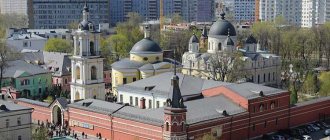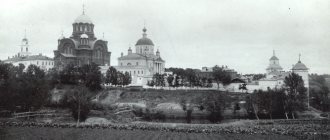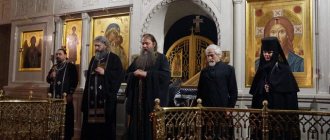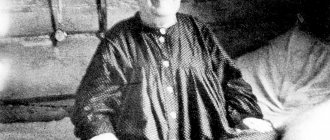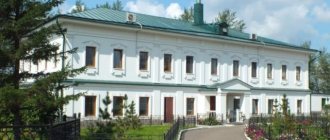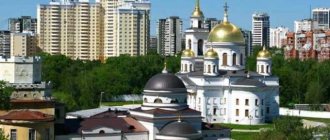History of the creation of the monastery
Incredibly, on the site of today’s blessed monastery, there used to be a rather dark, even cursed place. The so-called “Wretched House” was located here. This means that here, in the deep forest, the corpses of deceased disadvantaged and outcast people (homeless people, tramps, drunkards, cursed by the Church) were brought from all over the area.
Every year on Mother's Saturday, clergy came here with religious processions and performed funeral services and memorial services. According to legend, the body of False Demetrius was brought here. But even after his death, the traitor had no peace. His corpse was found in different places, as if some evil force was making fun of him. In the end, a week later, the Pretender’s body was burned, and the ashes were fired from a cannon to the place from where he came to Russia . This is the place where the holy monastery subsequently grew up.
Poor houses were created in Rus' following the example of ancient Israeli villages, called “skudelnichnye”. There they buried wanderers who came to the Jerusalem temple for the holiday and died suddenly. In our country, such places were called poor houses, pitiful places, rotting places, wretched houses. Suicides, tramps, drowned people, and those who were not entitled to Christian burial were brought here. Before death, worthy believers were given the Holy Mysteries of Christ and buried near the temple.
If it was winter, the bodies were simply thrown into the barn, and when the ground thawed, they were buried. In the summer, everyone was thrown into a hole and covered with earth. It was on the site of such a wretched house that a monastery was later built .
In 1635, Tsar Mikhail Romanov ordered the construction of the holy monastery to begin and gave the land for it. For unknown reasons, the monastery did not immediately begin to be built, but only a quarter of a century later under his descendant, Tsar Alexei the Quiet. At first a one-domed church was built, later a large brick temple and a bell tower appeared.
At first the monastery was for men, and Stefan became its first abbot. The monastery was assigned to the Moscow diocese. The monastery was illuminated in honor of the great holiday - the Intercession of the Most Holy Theotokos. Just as then, many years ago, the Mother of God covered the gathering of believers with Her omophorion, so to this day She continues to extend Her Cover over the monastery and over everyone who is there.
History of the foundation of the Intercession Monastery
Before the construction of the monastery, a Poor House was built here, on a deserted field where forts against the Tatars and Lithuanians had previously been located. The corpses of those who did not live according to the canons of the church, but who spent their entire lives trying to violate them (thieves, murderers, blasphemers, etc.), were brought here. In May 1606, the body of False Dmitry was brought to the Pokrovsky Poor House, which aroused great natural unrest and dark signs in these places.
The people began to worry, it was decided to burn the corpse and scatter the ashes to where the damned “sorcerer” Otrepiev came from. After some time, the remains of the martyr Demetrius, for whom False Dmitry pretended to be, were transferred to the capital from Uglich.
- The founder of the Pokrovsky Monastery, which replaced the Poor House, is Tsar Mikhail Fedorovich. A special motive for its creation was the procession of the cross held in honor of the Feast of the Intercession of the Virgin Mary. Another motivation was the king’s desire to honor the memory of his father and grandfather. In 1635 he granted his own lands for construction. After 20 years, the king gave six dessiatines from the Simonovsky Monastery to the new monastery.
- The first abbot of the monastery was the Monk Stefan, whose name is mentioned in the inscription of the altar cross and the letter of Alexy Mikhailovich. The monastery had a stone cathedral and a single-domed church, built in honor of the Intercession of the Virgin Mary. On the territory there were fraternal cells and a seminary, where meals and monastic services were held. The entire complex was surrounded by a stone fence with five towers.
- During the reign of Peter the Great, the financial condition of the Intercession Monastery was limited, the number of monks decreased significantly, and the buildings fell into disrepair. Life in the monastery was supported only by rich and pious landowners. The main church and cathedral were dismantled.
- The work of restoration was taken up by the Christian zealot Elder John, whose meek disposition attracted wealthy people to the resurrection of the Intercession Monastery.
Intercession Monastery, interior decoration - After the burning of Moscow in 1812, the abbot advocated another reconstruction. Two years later, the newly built buildings were consecrated by Archbishop Augustine. After the events of 1812, services were resumed in the monastery, and a large bell was poured out. After the death of the Monk Jonah, the position of rector was given to Father Ambrose, who took care of the appearance and correct order of rites. During his leadership, the Intercession Monastery flourished.
The fate of the monastery to the present day
In 1870, the church complex led by St. Innocent received missionary status. Here they trained monks who were supposed to carry the teachings of Christ in cold and distant Siberia. After 23 years, a Sunday school for boys was opened on the territory of the monastery, as well as a hotel for visiting missionaries.
- Seven monks of the Intercession Monastery went to the front during the First World War to serve as shepherds. In 1917, the church complex was a real center of spiritual education for the local population. During the years of Soviet power, monks were infringed on their rights, and the buildings were used for various purposes. It was supposed to create a concentration camp on the territory, but this was not destined to come true. The monastery was finally closed in 1928.
- The revival of the Intercession church complex took place in 1995. Patriarch Alexy II blessed the establishment of a stauropegic convent here, the first abbess of which was Feofania. Soon the charter was officially approved, and in October a religious procession was held after the solemn liturgy. In 1996, the Moscow government transferred the buildings of churches, chapels and bell towers to the Intercession Monastery for indefinite management.
New history of the monastery
The monastery expanded, and in the eighteenth century there was already a seminary there and quite a few cells. There were already fifty inhabitants then. When the plague raged in Rus', hospitals were set up in the monastery, where the sick were brought for treatment.
During the Patriotic War of 1812, the monastery was captured by the French and destroyed. But later it was restored. There was a necropolis around the monastery.
Prominent church figures are buried there:
- Archbishop Filaret, educator of Siberia.
- Archimandrite Veniamin, rector of the Vysokopetrovsky Monastery.
- Jonah, Metropolitan of Georgia.
- Neophyte, Metropolitan of Lebanon and Iliopolis.
The parishioners of the monastery who gave her alms are also buried in the cemetery. Among them: Pushchina, Morozov, etc. Athonite monks also lived in the monastery.
At the end of the nineteenth century, a miracle occurred in the monastery. Lightning flew into the window of the temple and made several circles in the air. Then, touching the icon of the Sign of the Mother of God, she flew out the opposite window. Since then, the brethren have served prayer services at this icon.
At the beginning of the twentieth century, the monastery was densely populated and developed. The seminary was working, church services were held every day. A magnificent orchard was laid out. During the First World War, an infirmary for wounded soldiers was set up in the monastery.
After the revolution of 1917, the monks were ordered to send all the fruits from the monastery garden to the workers . In 1919, an order was given to the abbot and the brethren to vacate the monastery in order to locate a kindergarten on this site. But the monks refused to carry out the order and continued to serve the services. In 26, the bell tower was demolished by the Red Army. In 29, the monastery was finally closed.
The restoration of the monastery began in 1995. Patriarch Alexy II blessed the revival of a convent on this site. Feofania was appointed abbess. That same year, on the Feast of the Intercession, the first liturgy after the closure took place.
Mother Abbess greatly revered Saint Matrona and often visited her grave. Once, while visiting His Holiness the Patriarch, mother was not in the monastery. When she returned, the Patriarch asked: “Where has she been?” She replied that she revered Matrona very much, and if her relics were transferred to this monastery, then the abbess would not have to leave the monastery. The Patriarch promised to think about it.
Feofania prayed to God that the saint’s relics would be transferred to her monastery. Immediately she has a dream that Matrona visited the monastery. Mother Abbess fell at her feet and began to beg her to stay here. She looked around the entire territory and said that she liked it here, the only thing missing here was an orphanage. The saint loved children and always helped everyone. The Mother Superior promised that she would build a shelter, then Matrona agreed to stay .
Upon awakening, the abbess received news that the Patriarch had given his blessing to transfer the relics of Matrona to the Intercession Monastery. In 1998, the glorification of her relics took place, and then they were transferred to the Danilov Monastery. After this, a religious procession brought the relics to the Intercession Monastery. Here they rest to this day.
Useful article on the topic: “How to get to the relics of St. Mother Matrona.”
Relics of the Venerable Matrona of Moscow
The Pokrovsky Monastery in Moscow acquired the relics of the Venerable Elder Matrona of Moscow in 1988. During her lifetime, the Saint healed many people with just one touch, had the gift of clairvoyance, and prayed around the clock. Matrona was miserable during her life; her legs and eyesight failed. But, despite her bodily injuries, mother saw right through everyone who came to her.
Interesting! Mother Matrona predicted such fateful events for Russia as the revolution and the Great Patriotic War!
After her death, mother continued to work miracles at her grave at the Danilovsky cemetery and during her lifetime she bequeathed to all believers to come to her grave and talk as if she were alive.
Modern view of the monastery
Currently the following buildings are located in the monastery:
- The main temple is the cathedral in honor of the Feast of the Intercession of the Blessed Virgin Mary. This is a two-story building, built in a classical style with a round dome. It is here that the main shrine is located - the relics of Saint Matrona.
- The Cathedral of the Resurrection of the Word is a five-domed temple built by the architect Bykovsky in the Romanov style.
- The thirty-meter bell tower , rebuilt in 1999 after the explosion. The stone was laid by the Patriarch of Moscow and All Rus' himself.
- Source of Saint Matrona . In it, believers collect healing water throughout the year.
- Chapel of Saints Peter and Fevronia. The temple was rebuilt in 2014 according to the surviving memories. Couples get married there because Saints Peter and Fevronia are the patron saints of marriage. The church also has a large baptismal font for adults.
- Necropolis . Many famous personalities are buried here, but during the years of Soviet power, the cemetery was turned into a park. Only a few graves have survived. A memorial cross has been erected here.
The monastery has a church shop where you can buy icons, books, candles, and submit notes for the liturgy. She works from eight in the morning to eight in the evening every day, seven days a week.
There is also a refectory on the territory of the monastery that can accommodate all the nuns and guests. In addition, there is a place for children to play - a playground with many swings, slides, and a trampoline.
Relics and shrines of the monastery
The main shrine is the honest relics of the blessed Matrona of Moscow. The monastery also stores other relics:
- Icon with a piece of the relics of St. Neil of Stolobensky.
- Icon of the Holy Blessed Prince Alexander Nevsky and the Holy Great Martyr George the Victorious.
- Icon of St. Nicholas the Wonderworker of Myra.
- Icon of the Mother of God “Seeking the Lost.”
- Icon of the Kiev-Pechersk saints with particles of relics.
- Icon of St. Sergius of Radonezh with a piece of relics.
Shrines
The main shrine of the Intercession Monastery is a shrine with the relics of the Venerable Elder Matrona of Moscow.
The second Shrine is the image of the Most Holy Theotokos “Seeking the Lost”, also associated with the Venerable Matrona. The old woman was looking for a talented icon painter for a long time to work on this image and finally found it. For a long time the work did not go well, and the artist came to his mother for advice. Matrona told him to confess and take communion before the case, which the icon painter did. After which things worked out well, and the icon was painted and transferred to the monastery.
Icon of the Mother of God Recovering the dead in the Holy Intercession Monastery
The patronal feast day at the Holy Intercession Convent is celebrated on October 14 - the day of the Intercession of the Blessed Virgin Mary.
Where can pilgrims stay?
On the territory of the monastery there is a cozy hotel that hospitably welcomes pilgrims. It has all the amenities, including for people with disabilities. There is a restaurant, laundry, library, Wi Fi. But there are often not enough places, it is worth booking rooms in advance.
Not far from the Intercession Monastery, on Taganka there are many hotels of different categories where believers can stay:
- Hotel Apartments on Taganskaya – just over 300 meters to the monastery.
- Hotel Apartlux Taganskaya Suite – about 700 meters to the monastery.
- Business Hotel Spectrum (Taganka) – 814 meters to the monastery.
- Mini-hotel Entrance No. 2 – 722 meters to the monastery.
- Hotel Taganka - 610 meters to the monastery - and other hotel complexes.
There are no special rules of behavior on the territory of the monastery . You just need to observe basic standards of decency (don’t shout, don’t use foul language, observe the rules of the hostel, women wear headscarves and skirts, don’t smoke, don’t show up drunk).
How to get there
The monastery is located on Taganskaya Street, 58 in the capital. You can get there by metro to the Marksistskaya , then take a trolleybus or bus to the Bolshaya Andronevskaya . Or go to the Proletarskaya and walk about five minutes to the Abelmanovskaya Zastava .
Video about how to get to the Intercession Monastery from the Proletarskaya station:
Opening hours and telephone number of the Intercession Convent in Moscow
Church services are held in the monastery every day.
- On weekdays, the Liturgy begins at 7.30 , evening - at 16.00 .
- On Sundays and holidays, two Liturgies are celebrated (at 6.15 and at 9 o'clock ). The schedule may change, it is better to check the information on site.
- The monastery is open every day from 7 a.m. on weekdays, and on holidays from 6 a.m. to 8 p.m.
Usually every morning, believers line up at the walls of the monastery to venerate the relics of Saint Matrona. Because there are quite a lot of people willing.
ADDITIONAL INFORMATION: ADDRESS. TELEPHONE. HOW TO GET THERE
Address: Moscow st. Taganskaya, 58 Phone: +7 495 911‑49-20, +7 495 911‑81-66 Official website: pokrov-monastir.ru
Opening hours: Mon-Sat 7:00–20:00; Sun 6:00–20:00
The Intercession Convent in Moscow on Taganka is an amazing place. Every day, from early morning to late evening, thousands of people make pilgrimages here with only one purpose - to honor the relics of the holy blessed Matrona and ask her for help, advice, and blessings. Despite the complex history, repeated damage, and persecution, the monastery was able to improve and do everything so that Matronushka would help the believers with their requests.
